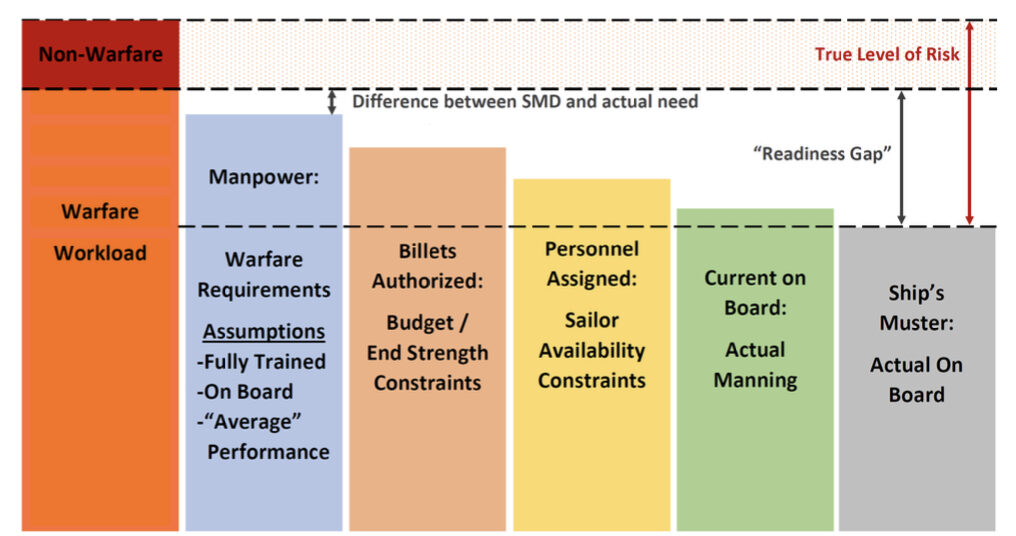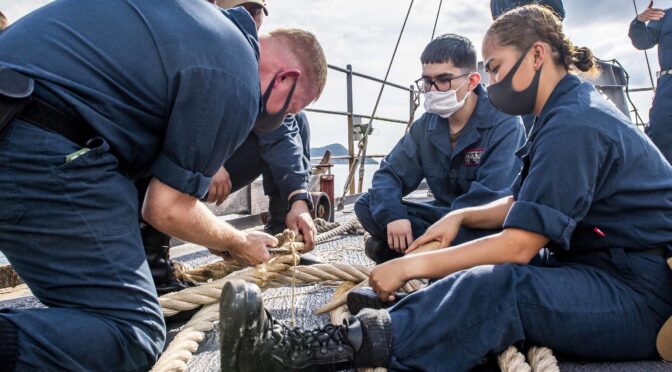By Capt. John Cordle (ret.)
The number 17 should have special meaning for the CNO, as it does for me. It is the number of Sailors we lost in the 2017 collisions, due to entirely preventable flaws. The CNO should continue to pay attention to the lessons from those events, and gauge the extent to which they have truly been learned and implemented. While those collisions happened more than six years ago, the process of learning from them remains very much a work in progress.
Among the many challenges highlighted by those fatal events, manning shortfalls and pervasive fatigue continue to persist. The U.S. Fleet Forces Comprehensive Review (CR) features the words “manning” and “fatigue” 117 times. In the years since the terrible events of 2017, the number of gapped Sailor billets at sea has still managed to increase from 6,592 (per the CR) to over 9,000, with many ships manned below 90 percent. Many have forgotten the fact that the USS Fitzgerald had no Quartermaster Chief for at least a year leading to the collision, and that the helm and lee helm driving the USS John S. McCain were cross-decked from another ship. Both the CR and the National Transportation Safety Board report cite a lack of manning as a major contributor to fatigue, which exacerbated both events, according to the investigations. The issues of manning and fatigue are inextricably linked. Fatigue is also linked to operational stress, mental health, and even suicide.

A cornerstone of the CNO’s duties is ensuring there are enough Sailors to serve at sea. Granted, there are limits to what the CNO can do, including topline budgets, recruiting and retention challenges, and a strong economy to compete against. But in the end, it comes down to setting firm priorities and making the tradeoffs. The best weapons in the world will fall short if they are manned by overworked and exhausted Sailors.
The CNO should pay close attention to two measures – the number of billets currently gapped at sea, and the average hours slept by sailors on ships. The measure of effectiveness will be for the former to go down and the latter to go up each month. If successful, the gaps will go from 9,000 to zero in four years, and the sleep average from 5.5 to 7 hours. The result will be improved operational effectiveness, quality of service, and safety. The memories of the Sailors we lost deserve no less.
Captain John Cordle is a retired Surface Warfare Officer who served as a Type Commander Personnel Officer and Chief of Staff, and twice Commanding Officer of Navy warships, USS Oscar Austin (DDG 79) and USS San Jacinto (CG 56). He is the recipient of the U. S. Navy League John Paul Jones Award for Inspirational Leadership.
Featured Image: EAST CHINA SEA (July 16, 2020) Deck department Sailors repair line using a technique called ‘serving’ on the forecastle of the amphibious dock landing ship USS Germantown (LSD 42). (U.S. Navy photo by Mass Communication Specialist 2nd Class Taylor DiMartino)


I know, I know… many accident investigations conclude that “crew rest” periods were violated. Accuse me of being rude and misinformed but, I see that many of those investigations are full of sloganology removing “personal ” blame and accountability from the sailor (officer? /enlisted?) I personally think the use of sailor “exhaustion” and “pervasive” fatigue are much, too much overused. I call it sloganology. As I read between the lines, I see untrained and undisciplined sailors operating ships for which they are not qualified to operate. Again, between the lines I see Commanding Officers who have not trained and educated their crews how to maintain themselves in a high paced environment. And the Commanding Officers… where were they when their ships entered extremis? In the rack? Where was the Commanding Officer on the ship I was sent to relieve early – because the ship ran aground??? In the rack. How can a ship rely on these individuals who enter a “pervasive” fatigued condition while fighting their ships? You cannot – maybe they should look for another form of employment. Maybe the Commanding Officer should have set up a more intensive screening and qualification process. Maybe we (Navy) need a more intensive screening/qualification process? Maybe the Navy could call it “Pervasive-Hyperintensive Sleep-Screening?” Hows that for sloganology?
Iron Mike, it sounds like you had a Command tour, so you must realize that even the CO is human, and thus- like the rest of us humans – still needs 6-8 hrs of sleep in 24. I’m guessing you slept occasionally as well. Those in charge were in fact held accountable, and many changes have been made since the 2017 collisions. If you look into at least one of the collisions (JSM) you will see that the crews were in fact “untrained” – the Navy installed a system without developing training or technical manuals. My point is we need to hold senior leaders accountable to properly man the ships and reexamine requirements that exceed resources – so our ships can sail safely into harm’s way.
I just received a NAVSEA briefing at North Island. Out of 100 candidates who apply for the Navy, only 27 can clear the hurdles to proceed. The top reasons for non-consideration are physical and mental challenges, drugs and alcohol use, and felony counts in their record. We have too many ships and too many watches under unbelievable stress. The Ops tempos are such that crews are over stressed physically/mentally and when that happens, mistakes can happen. The highest ops tempos are in the submarine fleet, as they are the tip of the point of the sword out there.
We have 80 ships in the build cycle right now, and we do not have the pipeline of sailors at all to handle them. That’s a fact. Until you solve for the recruitment and retention problems, the fatigue will not go away. This is what Congress and CNO need to focus on, realigning the needs of the service against the ops tempos. And making structural changes, there is no reason a sailor who is on a medication to treat ADHD, adderall for example, can not function normally in select service roles. But today they are eliminated from consideration. And if you were arrested for marijuana possession in the past, as a felony, that should be dismissed from consideration since it’s widely legal now, in particular California the biggest Navy state in the country. CO’s can’t do it alone, they work with what they are given, I’ve heard it directly from them. They are doing the very best they can, and training hard.
The Air Force seems to be making some headway. https://breakingdefense.com/2024/11/us-air-force-hit-2024-recruiting-goal-by-meeting-americans-where-they-are-not-lowering-standards/
The problem is big defense industry doesn’t make any money manning the fleet. Turn recruiting, training and manning over to Raytheon and suddenly it will be a budgetary priority. It has been going on for so long now that it clearly is outside the CNOs preview to fix.
We digitized health records and Leidos has the contract to pull that data for recruiting. Now no one applying can hide their medical history and its badly hurting recruitment.
In 1968 while on USS Mariano G Vallejo Gold we did a study for NASA as a prelude to Skylab. They wanted to know the schedules they should set up for the astronauts zooming around the earth every 90 minutes with a sunrise sunset every time. We had a doctor on board who NASA got to perform the study.
Part of our crew was on an 8 hours on and 16 hours off cycle or a 24 hour day, while most of us were on an 6 hours on and 12 hours off schedule or an 18 hour day. That rotated our “daytime” relative to the 24 hour day. Two weeks mid-patrol the corpsman (who was on the 24 hour day schedule) would take measurements of pulse, and respiration, adding that to our total urine output and blood tests taken at the beginning and end of the study. When we arrived in Guam the information and samples were flown to Houston for NASA to analyze.
The results came back that the 24- hour team had nice sinusoidal rhythms to all the data collected, while those of us on the 18- hour day could have been plotted with a shotgun, they were all over the place. NASA then decided that astronauts should operate on a 24 hour day schedule.
The Navy never did see the results of that study, apparently, cause they kept the schedule from the days of the sailing ship, with the results we saw in 2017 and continue to see today. Sailors need rest,too. Just like astronauts.